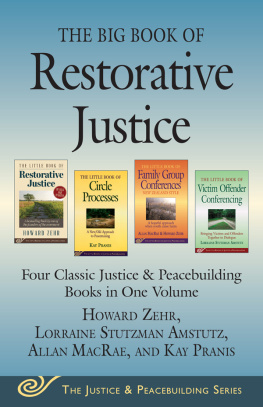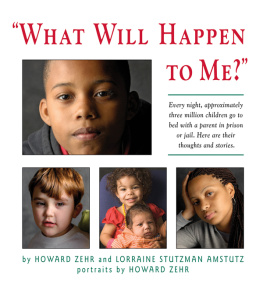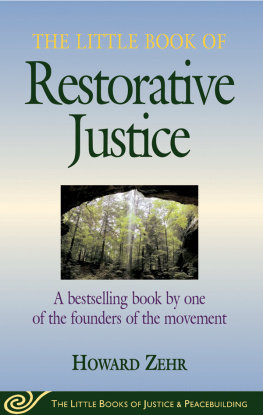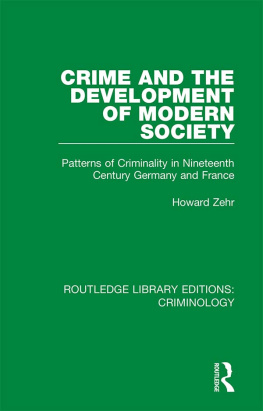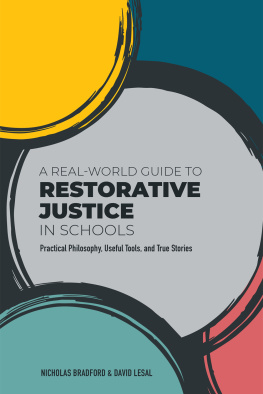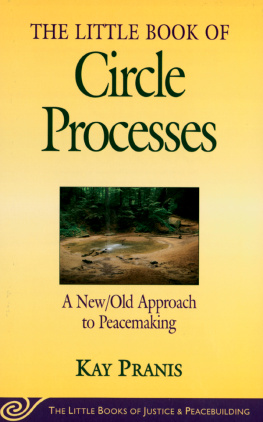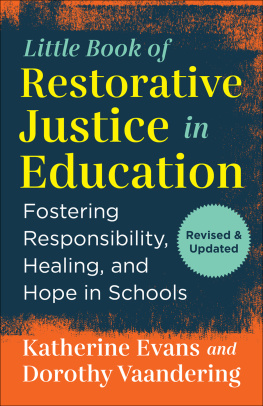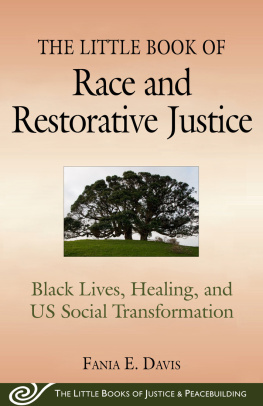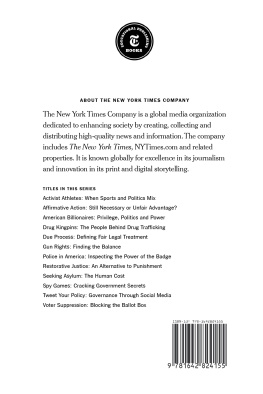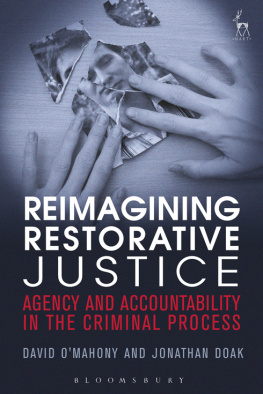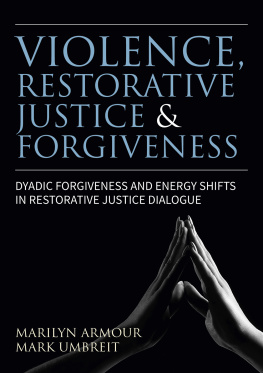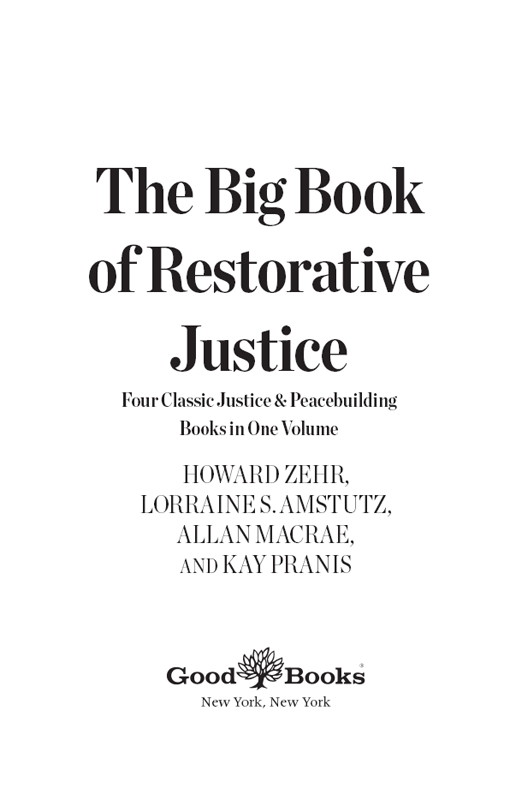Cover photograph by Howard Zehr
Copyright 2015 by Good Books, an imprint of Skyhorse Publishing, Inc.
All rights reserved. No part of this book may be reproduced in any manner without the express written consent of the publisher, except in the case of brief excerpts in critical reviews or articles. All inquiries should be addressed to Good Books, 307 West 36th Street, 11th Floor, New York, NY 10018.
Good Books books may be purchased in bulk at special discounts for sales promotion, corporate gifts, fund-raising, or educational purposes. Special editions can also be created to specifications. For details, contact the Special Sales Department, Good Books, 307 West 36th Street, 11th Floor, New York, NY 10018 or .
Good Books is an imprint of Skyhorse Publishing, Inc., a Delaware corporation.
Visit our website at www.goodbooks.com.
10 9 8 7 6 5 4 3 2 1
Library of Congress Cataloging-in-Publication Data is available on file.
ISBN: 978-1-68099-056-0
e-ISBN: 978-1-68099-114-7
Printed in the United States of America
The Justice & Peacebuilding series presents, in highly accessible form, key concepts and practices from the fields of restorative justice, conflict transformation, and peacebuilding. Written by leaders in these fields, they are designed for practitioners, students, and anyone interested in justice, peace, and conflict resolution.
The Justice & Peacebuilding series is a cooperative effort between the Center for Justice and Peacebuilding of Eastern Mennonite University and publisher Good Books.
Contents
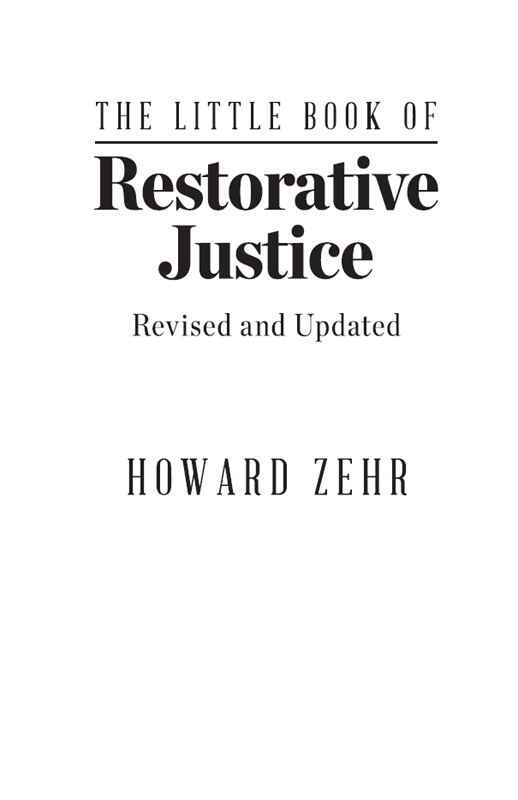
Table of Contents
Acknowledgments
A special thanks to the many friends and colleagues who gave me feedback on this manuscript. This includes my students, former students, and colleagues at the Center for Justice and Peacebuilding where I have taught since 1996. I especially want to thank Barb Toews, Jarem Sawatsky, Bonnie Price Lofton, Robert Gillette, Vernon Jantzi, Larissa Fast, and Ali Gohar for their careful attention and suggestions.
For this new edition, I am especially thankful to Sujatha Baliga for her careful reading and suggestions.
CHAPTER 1
An Overview
H ow should we as a society respond to wrongdoing? When a crime occurs, when an injustice or harm is committed, what needs to happen? What does justice require? The urgency of this question is emphasized daily by events reported in the media.
Whether we are concerned with crime or other offenses and harms, the Western legal system has profoundly shaped our thinking about these issuesnot only in the Western world, but in much of the rest of the world as well.
The Western legal systems approach to justice has some important strengths. Yet there is also a growing acknowledgment of this systems limits and failures. Those who have been harmed, those who have caused harm, and community members in general often feel that the criminal justice process shaped by this legal system does not adequately meet their needs. Justice professionalslaw enforcement officers, judges, lawyers, prosecutors, probation and parole officers, prison stafffrequently express a sense of frustration as well. Many feel that the criminal justice process deepens societal wounds and conflicts rather than contributing to healing or peace.
Restorative justice is an attempt to address some of these needs and limitations. Since the 1970s, a variety of programs and practices have emerged in thousands of communities and many countries throughout the world. Often these are offered as choices within or alongside the existing legal system, although in some occasions they are used as an alternative to the existing system. Since 1989, New Zealand has made restorative conferences the hub of its entire youth justice system.
In many places today, restorative justice is considered a sign of hope and the direction of the future. Whether it will live up to this promise remains to be seen, but many are optimistic.
Restorative justice began as an effort to deal with burglary and other property crimes that are usually viewed (often incorrectly) as relatively minor offenses. Today, however, restorative approaches are available in some communities for the most severe forms of criminal violence: death from drunken driving, assault, rape, even murder. Building upon the experience of the Truth and Reconciliation Commission in South Africa, efforts are also being made to apply a restorative justice framework to situations of mass violence.
These approaches and practices are also spreading beyond the criminal justice system to schools and universities, to the workplace, and to religious institutions. Some advocate the use of restorative approaches such as circles processes (a practice that emerged from First Nation communities in Canada) as a way to work through, resolve, and transform conflicts in general. Others pursue circle processes and other restorative approaches as a way to build and heal communities. Kay Pranis, a prominent restorative justice advocate, calls circles a form of participatory democracy that moves beyond simple majority rule.
In societies where Western legal systems have replaced and/or suppressed traditional justice and conflict-resolution processes, restorative justice is providing a framework to reexamine and sometimes reactivate these traditions. I sometimes envision restorative justice as a blend of key elements in modern human rights sensibilities and traditional approaches to harm or conflict.
Although the term restorative justice encompasses a variety of programs and practices, at its core it is a set of principles and values, a philosophy, an alternate set of guiding questions. Ultimately, restorative justice provides an alternative framework for thinking about wrongdoing. I will explore that framework in the pages that follow and illustrate how it translates into practice.
Why this Little Book ?
In this Little Book , my intention is not to make the case for restorative justice. Nor do I explore the many implications of this approach. Rather, I intend this book to be a brief description or overviewthe CliffsNotes , if you willof restorative justice. Although I will outline some of the programs and practices of restorative justice, my focus in this book is especially the principles or philosophy of restorative justice. Other books in this Little Books of Justice & Peacebuilding series explore practice models more thoroughly; a list of these is provided at the end of this book.
The Little Book of Restorative Justice is for those who have heard the term and are curious about what it implies. But it is also an attempt to bring clarity to those of us involved in the field because it is so easy to lose clarity about our direction and what we have set out to do.
Restorative justice claims to be victim-oriented.
All social innovations have a tendency to lose their way as they develop and spread, and restorative justice is no different. With more and more programs being termed restorative justice, the meaning of that phrase is sometimes diluted or confused. Under the inevitable pressures of working in the real world, restorative justice has sometimes been subtly coopted or diverted from its principles.
The victim advocacy community has been especially concerned about this. Restorative justice claims to be victim-oriented, but is it really? All too often, victim groups fear, restorative justice efforts have been motivated mainly by a desire to work with those who have offended in a more positive way. Like the criminal system that it aims to improve or replace, restorative justice may become primarily a way to deal with those who have offended.

